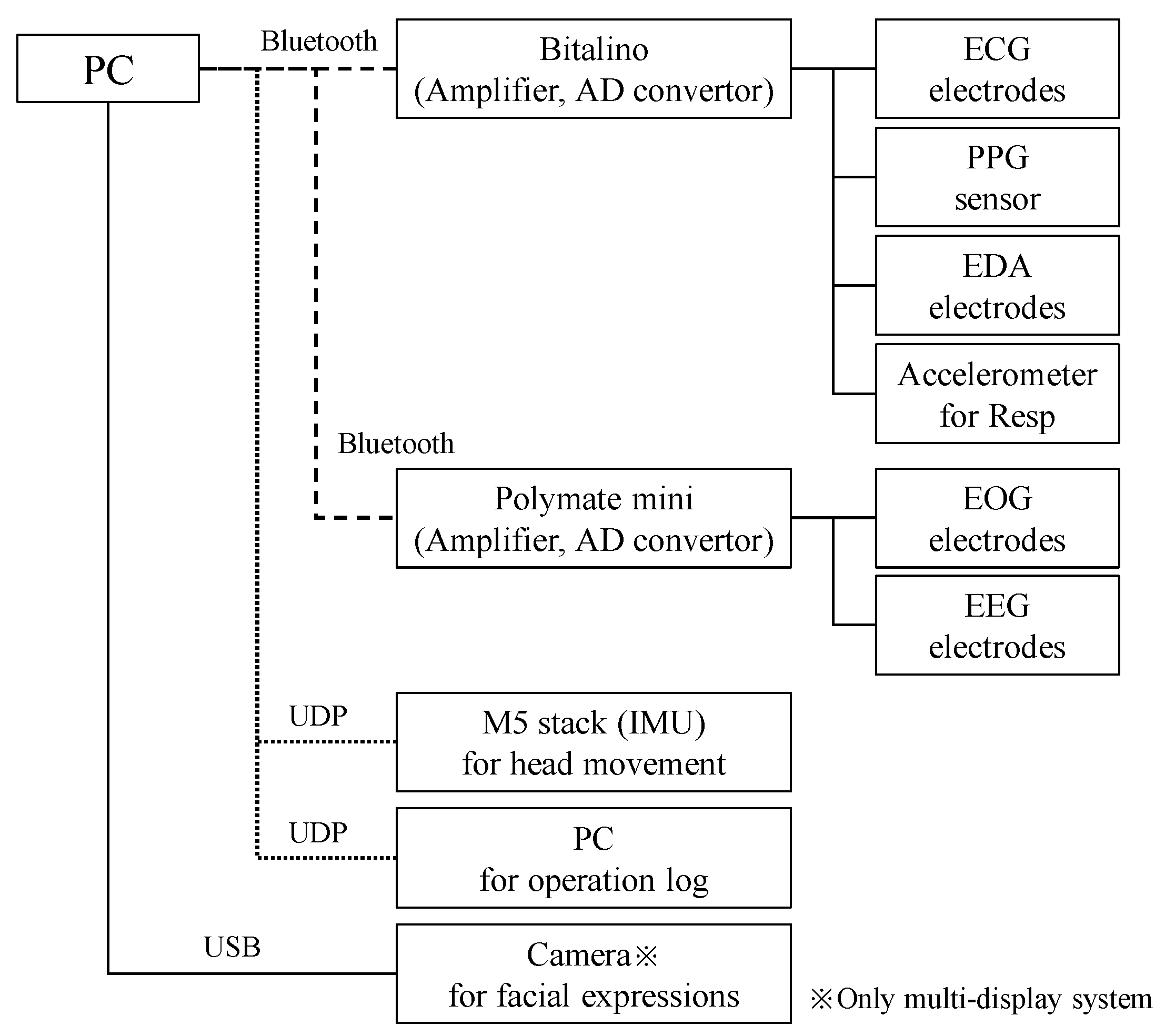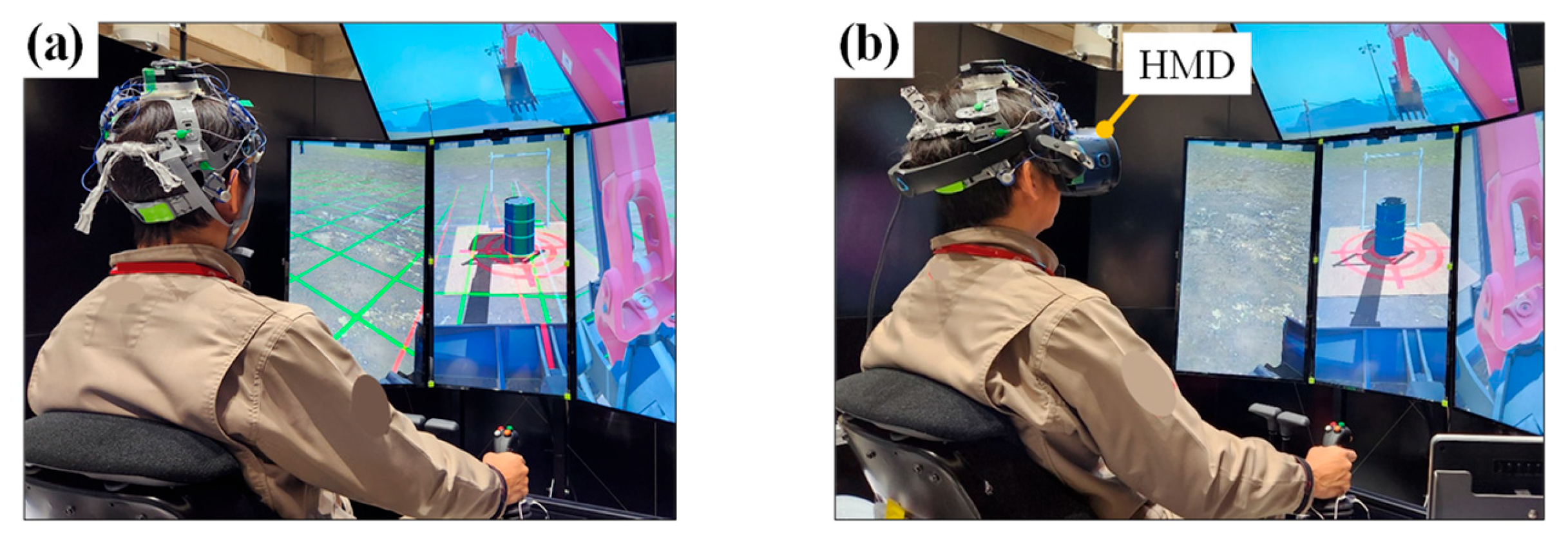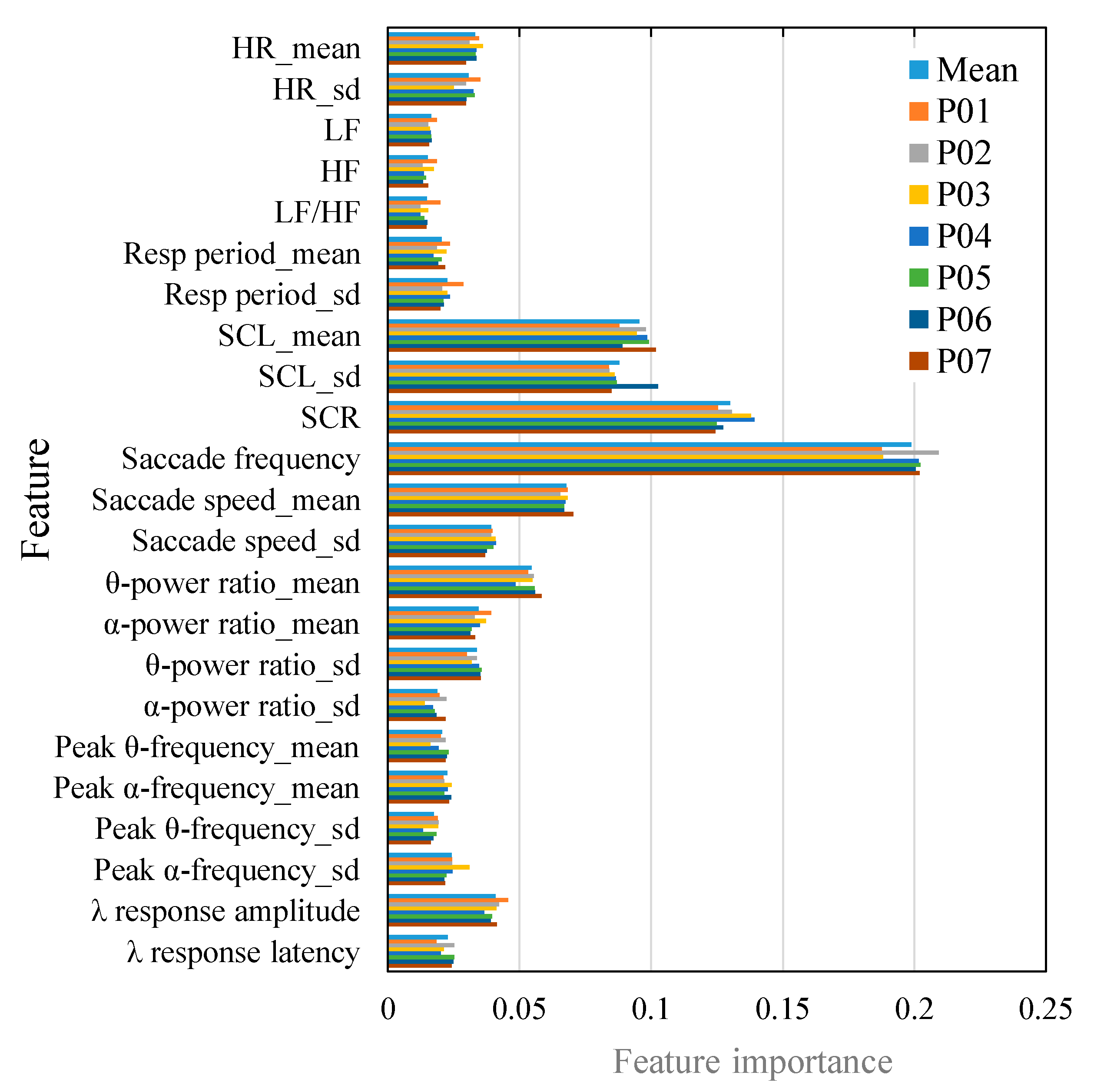Combined Method Comprising Low Burden Physiological Measurements with Dry Electrodes and Machine Learning for Classification of Visually Induced Motion Sickness in Remote-Controlled Excavator
Abstract
1. Introduction
2. System Overview
3. Acquisition of Data
3.1. Experimental Setting
3.2. Effect of Inducing VIMS
4. Model Construction
4.1. Preprocessing Method
4.1.1. VIMS Level
4.1.2. ECG
4.1.3. Resp
4.1.4. EDA
4.1.5. EOG
4.1.6. EEG
4.1.7. Standardization and Interpolation of Missing Values
4.2. Parameter Tuning and Validation Method
4.3. Evaluation Index for Classification Model
5. Results
6. Discussion
6.1. Accuracy Rate
6.2. ECG
6.3. Resp
6.4. EDA
6.5. EOG
6.6. EEG
7. Conclusions
Author Contributions
Funding
Institutional Review Board Statement
Informed Consent Statement
Data Availability Statement
Acknowledgments
Conflicts of Interest
References
- MLIT Japan. Available online: https://www.mlit.go.jp/tec/i-construction/index.html (accessed on 13 February 2023).
- Bos, J.E.; Bles, W.; Groen, E.L. A theory on visually induced motion sickness. Displays 2008, 29, 47–57. [Google Scholar] [CrossRef]
- Keshavarz, B.; Peck, K.; Rezaei, S.; Taati, B. Detecting and predicting visually induced motion sickness with physiological measures in combination with machine learning techniques. Int. J. Psychophysiol. 2022, 176, 14–26. [Google Scholar] [CrossRef] [PubMed]
- Moteki, M.; Akihiko, N.; Yuta, S.; Mishima, H.; Fujino, K. Research on Improving Work Efficiency of Unmanned Construction Improving Work Efficiency of Unmanned Construction by Using Appropriate Visual Information and Necessity of Haptic Function for Construction Machine Operation Interface. In Proceedings of the 33rd International Symposium on Automation and Robotics in Construction, Auburn, AL, USA, 18–21 July 2016. [Google Scholar]
- Matsuyama, A.; Minoshima, M.; Watanabe, H.; Ujike, H.; Endou, H. Visually Induced Motion Sickness in Operation of Remote Control Hydraulic Excavator. In Proceedings of the 19th Symposium on Construction Robotics in Japan, Fukuoka, Japan, 9–11 October 2019. [Google Scholar]
- Ito, S.; Sakano, Y.; Fujino, K.; Ando, H. Remote Controlled Construction Equipment by Using High-resolution Stereoscopic 3D Images. J. Jpn. Soc. Civ. Eng. Ser. F3 Civ. Eng. Inform. 2017, 73, 15–24. [Google Scholar]
- Miyazaki, J.; Yamamoto, H.; Ichimura, Y.; Yamashiro, H.; Murase, T.; Yamamoto, T.; Umeda, M.; Higuchi, T. Inter-hemispheric desynchronization of the human MT+ during visually induced motion sickness. Exp. Brain Res. 2015, 233, 2421–2431. [Google Scholar] [CrossRef]
- Liu, R.; Cui, S.; Zhao, Y.; Chen, X.; Yi, L.; Hwang, A.D. VIMSNet: An effective network for visually induced motion sickness detection. Signal Image Video Process. 2022, 16, 2029–2036. [Google Scholar] [CrossRef]
- Yoshioka, N.; Takeuchi, H.; Shu, Y.; Okamatsu, T.; Araki, N.; Kamakura, Y.; Ohsuga, M. Low Burden Multidimensional Physiological Measurements Toward Estimation of Excavator Operator Condition. In Proceedings of the 22nd Triennial Congress of International Ergonomics Association, Jeju, Republic of Korea, 25–29 August 2024. [Google Scholar]
- COCOMI. Available online: https://www.toyobo.co.jp/discover/materials/cocomi/ (accessed on 30 March 2023).
- Sumitomo Bakelite Co., Ltd. Press Release. 2024. Available online: https://www.sumibe.co.jp/topics/2024/bmi/0411_01/index.html (accessed on 10 May 2024).
- DuraQ®. Available online: https://www.sumibe.co.jp/solution/mobility/AD_ADAS/duraq.html (accessed on 20 March 2023).
- Klem, G.H.; Lüders, H.O.; Jasper, H.H.; Elger, C. The ten-twenty electrode system of the International Federation. Electroencephalogr. Clin. Neurophysiol. Suppl. 1999, 52, 3–6. [Google Scholar]
- Moteki, M.; Fujino, K.; Yuta, S. The Proposal of the Model Task for Efficiency Evaluation of the Construction Work by Remote Control of a Hydraulic Excavator. Constr. Mach. Constr. 2014, 66, 71–79. [Google Scholar]
- Kojima, T.; Ohsuga, M.; Kamakura, Y.; Hori, J.; Watanabe, S. Assessment of car sickness in passengers using physiological indices. In Proceedings of the IEEE International Conference on Systems, Man, and Cybernetics, Prague, Czech Republic, 9–12 October 2022. [Google Scholar]
- Keshavarz, B.; Hecht, H. Validating an Efficient Method to Quantify Motion Sickness. Hum. Factors 2011, 53, 415–426. [Google Scholar] [CrossRef]
- Kennedy, R.; Lane, N.; Berbaum, K.; Lilienthal, M. Simulator Sickness Questionnaire: An Enhanced Method for Quantifying Simulator Sickness. Int. J. Aviat. Psychol. 1993, 3, 203–220. [Google Scholar] [CrossRef]
- Sasaki, T.; Matsumoto, S. Actual Conditions of Work, Fatigue and Sleep in Non-Employed, Home-Based Female Information Technology Workers with Preschool Children. Ind. Health 2005, 43, 142–150. [Google Scholar] [CrossRef]
- Takeuchi, H.; Ohsuga, M.; Kamakura, Y.; Yoshioka, N.; Shu, Y.; Okamatsu, T.; Araki, N. Towards Evaluating Visually Induced Motion Sickness Using Facial Expressions -Investigation in a Simulated Remote Control Environment Using Hydraulic Excavator Simulator. Jpn. Acad. Facial Stud. 2023, 23, 81–93. [Google Scholar]
- Ke, G.; Meng, Q.; Finley, T.; Wang, T.; Chen, W.; Ma, W.; Ye, Q.; Liu, T. LightGBM: A highly efficient gradient boosting decision tree. In Proceedings of the 31st International Conference on Neural Information Processing Systems, Long Beach, CA, USA, 4–9 December 2017. [Google Scholar]
- Lessons Learned From Bench-Marking Fast Machine Learning Algorithms. Available online: https://docs.microsoft.com/ja-jp/archive/blogs/machinelearning/lessons-learned-benchmarking-fast-machine-learning-algorithms (accessed on 25 October 2020).
- Shi, H. Best-First Decision Tree Learning. Master’s Thesis, University of Waikato, Hamilton, New Zealand, 2007. [Google Scholar]
- Acharya, U.R.; Joseph, K.P.; Kannathal, N.; Lim, C.M.; Suri, J.S. Heart rate variability: A review. Med. Biol. Eng. Comput. 2006, 44, 1031–1051. [Google Scholar] [CrossRef] [PubMed]
- Ohsuga, M. On a QRS Detection Algorithm Applicable to the Evaluation of Mental State in Normal Subjects. Jpn. J. Med. Electron. Biol. Eng. 1992, 30, 121–129. [Google Scholar]
- Nakagawa, C.; Ohsuga, M. Program and its application to respiratory waveform analysis -Case study on motion sickness. Jpn. J. Ergon. 2007, 43, 33–40. [Google Scholar]
- Abrams, R.A.; Meyer, D.E.; Kornblum, S. Speed and accuracy of saccadic eye movements: Characteristics of impulse variability in the oculomotor system. J. Exp. Psychol. Hum. Percept. Perform. 1989, 15, 529–543. [Google Scholar] [CrossRef]
- Fukuda, R.; Sakuma, M.; Nakamura, E.; Fukuda, T. An experimental consideration on the definition of a fixation point. J. Jpn. Hum. Factors Ergon. Soc. 1996, 32, 198–204. [Google Scholar]
- Yoshioka, N.; Kimura, T.; Shu, Y.; Okamatsu, T.; Araki, N.; Ohsuga, M. Evaluation of the tiller switch layout of a tractor using eye-fixation related potentials. In Proceedings of the 42nd Annual International Conference of the IEEE Engineering in Medicine & Biology Society, Montreal, QC, Canada, 20–24 July 2020. [Google Scholar]
- A Hyperparameter Optimization Framework. Available online: https://optuna.readthedocs.io/en/stable/index.html (accessed on 8 December 2020).
- Bergstra, J.; Bardenet, R.; Bengio, Y.; K’egl, B. Algorithms for hyper-parameter optimization. In Proceedings of the 24th International Conference on Neural Information Processing Systems, Granada, Spain, 12–17 December 2011. [Google Scholar]
- Bergstra, J.; Yamins, D.; Cox, D. Making a science of model search: Hyperparameter optimization in hundreds of dimensions for vision architectures. In Proceedings of the 30th International Conference on Machine Learning, Atlanta, Georgia, USA, 17–19 June 2013. [Google Scholar]
- Landis, J.R.; Koch, G.G. The measurement of observer agreement for categorical data. Biometrics 1997, 33, 159–174. [Google Scholar] [CrossRef]
- Lin, Y.; Chien, Y.; Wang, H.; Lin, F.; Huang, Y. The Quantization of Cybersickness Level Using EEG and ECG for Virtual Reality Head-Mounted Display. Hum. Factors AR/VR Syst. 2018, 49, 862–865. [Google Scholar] [CrossRef]
- Nakagawa, C.; Ohsuga, M.; Takeda, T. Basic study toward VE-sickness assessment. Jpn. J. Ergon. 2000, 36, 131–138. [Google Scholar]
- Himi, N. Analysis of Autonomic Nervous Reactions Accompanying Nausea Induced by Visual Stimulation. Kawasaki Med. J. 2002, 28, 229–241. [Google Scholar]
- Mark, S.D.; Zachary, W.A.; Michael, D. Use of physiological signals to predict cybersickness. Display 2016, 44, 42–52. [Google Scholar]
- Javaid, A.; Chouhna, H.; Varghese, B.; Hammam, E.; Macefield, V.G. Changes in skin blood flow, respiration and blood pressure in participants reporting motion sickness during sinusoidal galvanic vestibular stimulation. Exp. Physiol. 2019, 104, 1622–1629. [Google Scholar] [CrossRef] [PubMed]
- Young, Y.K.; Hyun, J.K.; Eun, N.K.; Hee, D.K.; Hyun, T.K. Characteristic changes in the physiological components of cybersickness. Psychophysiology 2005, 42, 616–625. [Google Scholar]
- Denise, P.; Vouriot, A.; Normand, H.; Golding, J.F.; Gresty, M.A. Effect of temporal relationship between respiration and body motion on motion sickness. Auton. Neurosci. 2009, 151, 142–146. [Google Scholar] [CrossRef] [PubMed]
- Adhanom, I.; Halow, S.; Folmer, E.; MacNeilage, P. VR Sickness Adaptation With Ramped Optic Flow Transfers From Abstract To Realistic Environments. Front. Virtual Real. 2022, 3, 848001. [Google Scholar] [CrossRef]
- Magaki, T.; Vallance, M. Developing an Accessible Evaluation Method of VR Cybersickness. In Proceedings of the 26th Annual IEEE Conference on Virtual Reality and 3D User Interfaces, Osaka, Japan, 23–27 March 2019. [Google Scholar]
- Wibirama, S.; Santosa, P.I.; Widyarani, P.; Brilianto, N.; Hafidh, W. Physical discomfort and eye movements during arbitrary and optical flow-like motions in stereo 3D contents. Virtual Real. 2020, 24, 39–51. [Google Scholar] [CrossRef]
- Chang, E.; Kim, H.T.; Yoo, B. Predicting cybersickness based on user’s gaze behaviors in HMD-based virtual reality. J. Comput. Des. Eng. 2021, 8, 728–739. [Google Scholar] [CrossRef]
- Yang, J.X.; Guo, C.T.; So, R.H.Y.; Cheung, R.T.F. Effects of Eye Fixation on Visually Induced Motion Sickness: Are they Caused by Changes in Retinal Slip Velocity? In Proceedings of the Annual Meeting of the Human Factors and Ergonomics Society, Las Vegas, NV, USA, 19–23 September 2011. [Google Scholar]
- Lim, H.K.; Ji, K.; Woo, Y.S.; Han, D.; Lee, D.H.; Nam, S.G.; Jang, K.M. Test-retest reliability of the virtual reality sickness evaluation using electroencephalography (EEG). Neurosci. Lett. 2021, 743, 135589. [Google Scholar] [CrossRef]
- Liu, R.; Xu, M.; Zhang, Y.; Peli, E.; Hwang, A.D. A Pilot Study on EEG-Based Evaluation of Visually Induced Motion Sickness. J. Imaging Sci. Technol. 2020, 64, 020501-1–020501-10. [Google Scholar]
- Ahn, M.H.; Park, J.H.; Jeon, H.; Lee, H.J.; Kim, H.J.; Hong, S.K. Temporal Dynamics of Visually Induced Motion Perception and Neural Evidence of Alterations in the Motion Perception Process in an Immersive Virtual Reality Environment. Front. Neurosci. 2020, 14, 600839. [Google Scholar] [CrossRef]
- Wu, J.; Zhou, Q.; Li, J.; Kong, X.; Xiao, Y. Inhibition-related N2 and P3: Indicators of visually induced motion sickness (VIMS). Int. J. Ind. Ergon. 2020, 78, 102981. [Google Scholar] [CrossRef]
- Adler, A.I.; Painsky, A. Feature importance in gradient boosting trees with cross-validation feature selection. Entropy 2022, 24, 687. [Google Scholar] [CrossRef] [PubMed]









| Participant | Maximum VIMS Level | Experimental Order | ||
|---|---|---|---|---|
| MD | HMD | Day1 | Day2 | |
| P01 | 1 | 3 | HMD | MD |
| P02 | 5 | 5 | MD | HMD |
| P03 | 5 | 5 | MD | HMD |
| P04 | 5 | 5 | MD | HMD |
| P05 | 1 | 5 | HMD | MD |
| P06 | 3 | 5 | MD | HMD |
| P07 | 2 | 5 | HMD | MD |
| P08 | 1 | 2 | MD | HMD |
| P09 | 1 | 1 | HMD | MD |
| Participants | Display Device | VIMS Level | |
|---|---|---|---|
| 1 or 2 | 3 or 4 | ||
| P01 | MD | 940 | - |
| HMD | 1342 | 1724 | |
| P02 | MD | 433 | 658 |
| HMD | 271 | 464 | |
| P03 | MD | 738 | 1093 |
| HMD | 313 | 616 | |
| P04 | MD | 1099 | 397 |
| HMD | 450 | 959 | |
| P05 | MD | 1056 | - |
| HMD | 1564 | 212 | |
| P06 | MD | 1185 | 736 |
| HMD | 511 | 446 | |
| P07 | MD | 1777 | - |
| HMD | 1848 | 212 | |
| P08 | MD | 617 | - |
| HMD | 761 | - | |
| P09 | MD | 3545 | - |
| HMD | 1544 | - | |
| Total | 19,994 | 9659 | |
| Participant | Accuracy | κ-Coefficient | ROC-AUC | PR-AUC |
|---|---|---|---|---|
| P01 | 0.76 | 0.38 | 0.72 | 0.81 |
| P02 | 0.82 | 0.66 | 0.84 | 0.90 |
| P03 | 0.91 | 0.73 | 0.96 | 0.98 |
| P04 | 0.80 | 0.39 | 0.76 | 0.69 |
| P05 | 0.84 | 0.43 | 0.94 | 0.59 |
| P06 | 0.67 | 0.32 | 0.76 | 0.63 |
| P07 | 0.87 | 0.24 | 0.90 | 0.38 |
| Mean | 0.81 | 0.45 | 0.84 | 0.71 |
| Feature | Importance | R | R2 |
|---|---|---|---|
| HR_mean | 0.033 | 0.447 | 0.200 |
| HR_sd | 0.031 | −0.052 | 0.003 |
| LF | 0.017 | 0.154 | 0.024 |
| HF | 0.015 | 0.200 | 0.040 |
| LF/HF | 0.015 | −0.125 | 0.016 |
| Resp period_mean | 0.020 | 0.652 | 0.425 |
| Resp period_sd | 0.023 | 0.843 | 0.710 |
| SCL_mean | 0.096 | 0.101 | 0.010 |
| SCL_sd | 0.088 | 0.587 | 0.345 |
| SCR | 0.130 | 0.674 | 0.454 |
| Saccade frequency | 0.199 | −0.916 | 0.839 |
| Saccade speed_mean | 0.068 | 0.880 | 0.775 |
| Saccade speed_sd | 0.039 | 0.637 | 0.405 |
| θ-power ratio_mean | 0.055 | 0.642 | 0.413 |
| α-power ratio_mean | 0.034 | −0.581 | 0.337 |
| θ-power ratio_sd | 0.034 | −0.048 | 0.002 |
| α-power ratio_sd | 0.019 | 0.090 | 0.008 |
| Peak θ-frequency_mean | 0.021 | −0.543 | 0.295 |
| Peak α-frequency_mean | 0.023 | −0.691 | 0.478 |
| Peak θ-frequency_sd | 0.018 | −0.022 | 0.000 |
| Peak α-frequency_sd | 0.024 | −0.437 | 0.191 |
| λ response amplitude | 0.041 | 0.668 | 0.446 |
| λ response latency | 0.023 | 0.335 | 0.112 |
Disclaimer/Publisher’s Note: The statements, opinions and data contained in all publications are solely those of the individual author(s) and contributor(s) and not of MDPI and/or the editor(s). MDPI and/or the editor(s) disclaim responsibility for any injury to people or property resulting from any ideas, methods, instructions or products referred to in the content. |
© 2024 by the authors. Licensee MDPI, Basel, Switzerland. This article is an open access article distributed under the terms and conditions of the Creative Commons Attribution (CC BY) license (https://creativecommons.org/licenses/by/4.0/).
Share and Cite
Yoshioka, N.; Takeuchi, H.; Shu, Y.; Okamatsu, T.; Araki, N.; Kamakura, Y.; Ohsuga, M. Combined Method Comprising Low Burden Physiological Measurements with Dry Electrodes and Machine Learning for Classification of Visually Induced Motion Sickness in Remote-Controlled Excavator. Sensors 2024, 24, 6465. https://doi.org/10.3390/s24196465
Yoshioka N, Takeuchi H, Shu Y, Okamatsu T, Araki N, Kamakura Y, Ohsuga M. Combined Method Comprising Low Burden Physiological Measurements with Dry Electrodes and Machine Learning for Classification of Visually Induced Motion Sickness in Remote-Controlled Excavator. Sensors. 2024; 24(19):6465. https://doi.org/10.3390/s24196465
Chicago/Turabian StyleYoshioka, Naohito, Hiroki Takeuchi, Yuzhuo Shu, Taro Okamatsu, Nobuyuki Araki, Yoshiyuki Kamakura, and Mieko Ohsuga. 2024. "Combined Method Comprising Low Burden Physiological Measurements with Dry Electrodes and Machine Learning for Classification of Visually Induced Motion Sickness in Remote-Controlled Excavator" Sensors 24, no. 19: 6465. https://doi.org/10.3390/s24196465
APA StyleYoshioka, N., Takeuchi, H., Shu, Y., Okamatsu, T., Araki, N., Kamakura, Y., & Ohsuga, M. (2024). Combined Method Comprising Low Burden Physiological Measurements with Dry Electrodes and Machine Learning for Classification of Visually Induced Motion Sickness in Remote-Controlled Excavator. Sensors, 24(19), 6465. https://doi.org/10.3390/s24196465






